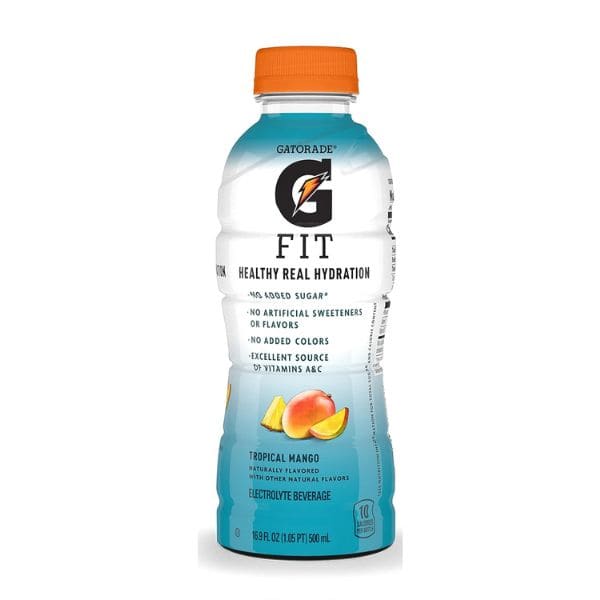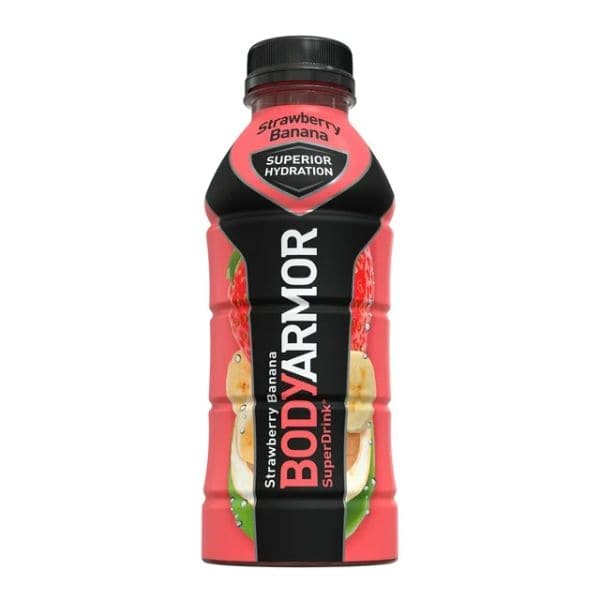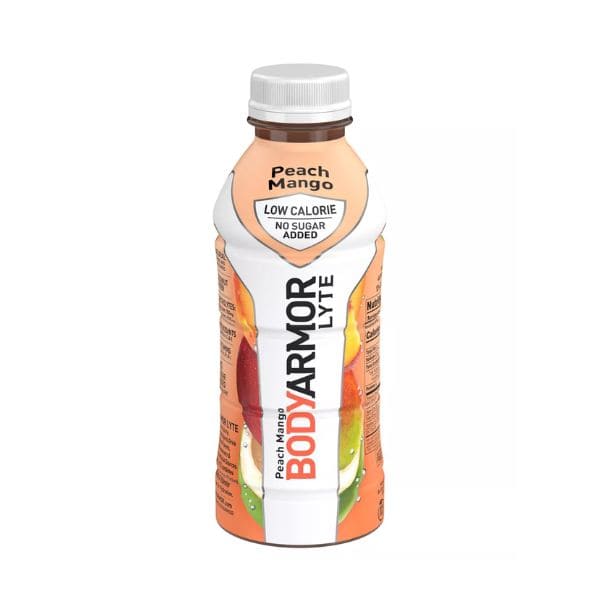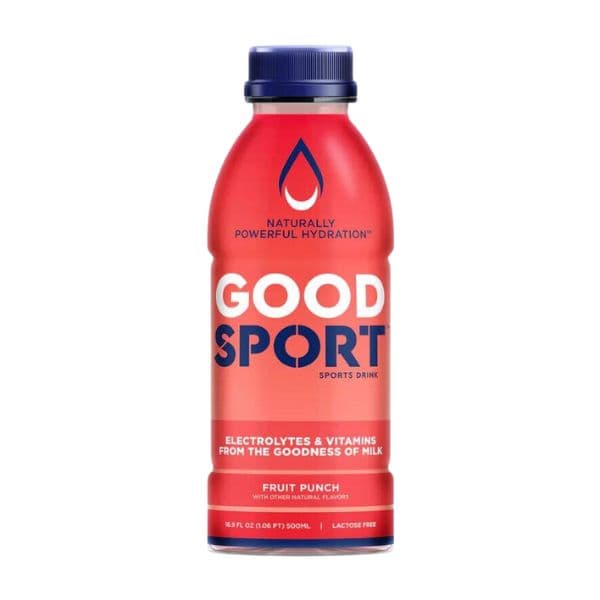Obviously, throwing around the word clean here, but in this post, I’ll compare the ingredients of many popular kids sports drinks and pinpoint the cleanest kids sports drink as well as some options that you may want to limit or avoid altogether.
Looking to get straight to the point? Feel free to skip right down to the sports drink comparison chart, which shows which sports drinks contain artificial sweeteners, flavors, dyes and excess sugar.

Do Kids Really Need Sports Drinks?
This post could start and finish with “just drink water,” but my kids are eight and twelve, so I get the expectation of providing the celebratory sports drink after the big game. Sports drinks are absolutely a staple at all varieties of kids sporting events here in the south.
Sports drinks got their start (at least in the U.S.) in the 1960’s and were designed for college football players at the University of Florida. They were not created with young children in mind.
Most doctors or nutritionists will tell you that kids usually don’t need sports drinks. Kids rarely play hard and long enough that water won’t do the job. Something many don’t realize is foods are a great way to replenish electrolytes also.
What Are Some Sports Drink Alternatives?
Here are six sports-friendly foods that are high in electrolytes:
- bananas
- watermelon
- sunflower seeds
- almonds
- dried apricots
- yogurt
You can also find lots of homemade electrolyte drink recipes online like this one by Saucy Kitchen. O.k. now back to our search for the cleanest kids sports drink.
What is Considered a Kids Sports Drink?
For purposes of this post, we will look at beverages with significant amounts of electrolytes that market themselves as sports drinks. Most sports drinks have about three different sources of electrolytes. Some have additional vitamins and antioxidants added as well.
Sports drinks are used to prevent dehydration and muscle cramps. This post will only compare caffeine free sports drinks as those are directly marketed to younger kids whereas caffeinated sports drinks tend to be geared more towards adults.
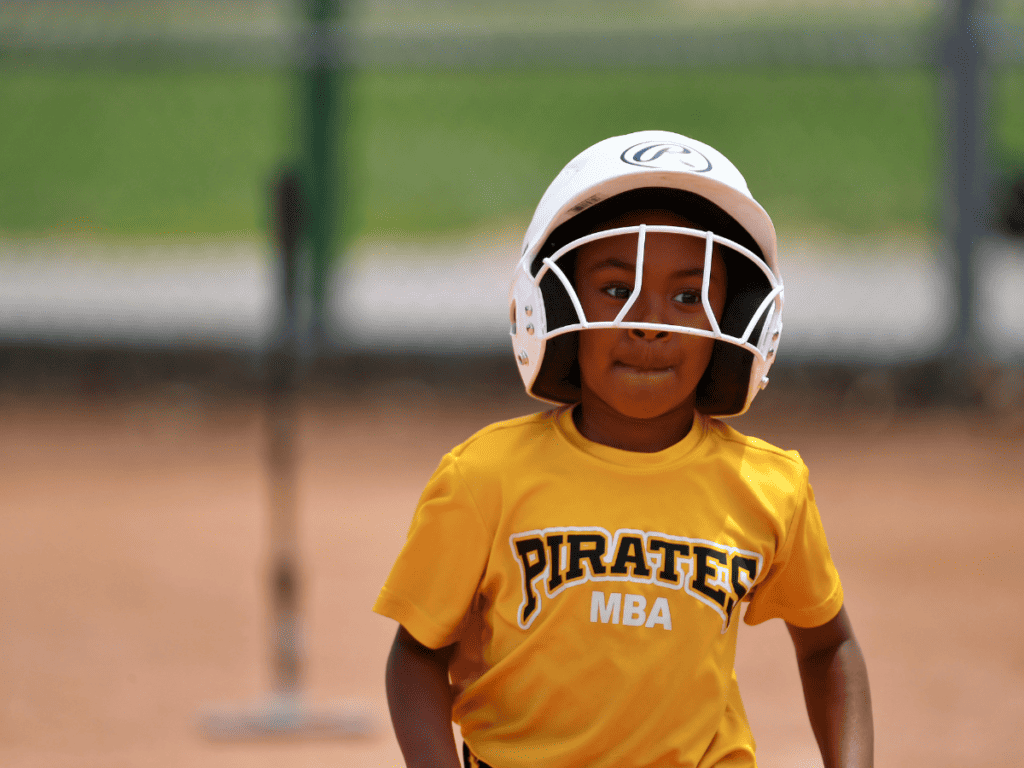
Common Ingredients in Kids Sports Drinks
Excess Sugar
Unfortunately, most sports drinks are loaded with sugar. Sugar sources in sports drinks are usually listed as can sugar (sucrose) or dextrose, which is a simple sugar made from corn (sometimes wheat).
More than 90% corn in the U.S is GMO and most of those crops are Roundup Ready (engineered to withstand heavy pesticide treatments). Because of these reasons, I prefer cane sugar to dextrose.
The American Heart Association recommends no more than 25 grams of added sugar per day for children over the age of two.
This number is easily exceeded with just one sports drink per day. If you’re trying to reduce overall sugar in your diet, here are eight simple ways.
Artificial Sweeteners
Many sports manufactures turn to sucralose and acesulfame potassium to create a sugar-free sports drink, but is it really healthier? Most experts now tell us that most artificial sweeteners are, in fact, not healthier and may even be worse for us.
Studies show they lead to obesity and Type 2 Diabetes just like traditional sugary beverages do. Sucralose has been shown to alter our gut microbiota, and one study showed people who consumed acesulfame potassium had a slightly higher risk of cancer.
Artificial Dyes
Food dye consumption has increased fivefold in the United States since 1955. Today, artificial food dyes are synthesized mainly from raw materials obtained from petroleum.
In particular, food dyes have been linked to hyperactivity and even aggression in children. Red 40, Yellow 5 and Yellow 6 make up about 90% of the artificial food dye used.

Natural and Artificial Flavors
While natural flavors aren’t perfect, they do contain common derivatives from fruits, veggies and other things found in nature. They do sometimes contain odd items … like say, beaver butt.
You’ll have to Google that, because I don’t want to talk about it here! Truthfully, it’s hard to know what is in “natural flavors” as it’s a blanket term that covers up to 100 ingredients.
That being said, the actual flavor like “strawberry” is preferred to “natural flavors,” but good luck trying to find that in a kids sports drink.
Artificial flavors are simply laboratory created flavors, and they are even more tricky, A few years ago, the FDA removed 7 worrisome ingredients that were previously approved for use in artificial flavors due to health concerns.
Additives
Citric acid is a common natural preservative that comes from citrus fruits hints the name. A related ingredient is sodium citrate, which is the sodium salt of citric acid. It’s used to add salty flavor and preserve foods and beverages.
Another common additive in sports drinks is potassium phosphate, which can be concerning in large amounts. Phosphates are particularly dangerous for people with kidney disease, which is something to keep in mind.
A sort of odd one is glycerol ester of rosin also known as ester gum that is naturally derived from pine trees and used to stabilize and thicken. Appetizing, huh?
While none of these are likely a big deal in small amounts, listing them off and mulling them over reminds me of the beauty of whole foods.
Caffeine
I think we all know what caffeine is. To be safe, you may want to skip any caffeine for kids. I personally skip the caffeine for myself these days too, but that’s a story for a different post.
Children and adolescents are also still developing and the impact of caffeine on their nervous systems and cardiovascular systems is not fully known. Too much caffeine can cause issues such as increased anxiety, increased heart rate and blood pressure, acid reflux and sleep disturbance.
Is Coffee Bad for Kids? – Johns Hopkins All Children’s Hospital (hopkinsmedicine.org)
Kids Sports Drink Comparison
Let’s dive in and compare ingredients to find the best kids sports drinks available.
We’ll start with the gold standard of sports drinks: Gatorade. Even with all of the new sports drinks on the scene now, lots of people stick to the tried-and-true Gatorade. There are so many versions, it’s hard to keep up with them all.

Gatorade
They offer the original Gatorade, Gatorade Zero, Gatorade Fit, Gatorlyte and Gatorade Fast Twitch. Gatorade Fast Twitch contains caffeine and isn’t marketed towards kids, so we won’t talk about it here.
Original Gatorade is sweetened with sugar and dextrose. A standard 20-ounce bottle contains 34 grams of sugar, which is more than the daily recommended amount of sugar for a kid. It also contains artificial dyes.
Gatorade Zero is similar to the original, but it uses artificial sweeteners, sucralose and acesulfame potassium, instead of sugar. It contains artificial dyes.
Gatorlyte has 12 grams of sugar and contains no artificial sweeteners or flavors. It is sweetened with sugar and stevia leaf extract. Gatorlyte does, however, contain artificial dyes.
Gatorade Fit is sweetened with juice concentrate and stevia leaf extract. It does not contain any artificial sweeteners, flavors or dyes. This is the winner of the Gatorades in my book and one of the contenders for best kids sports drinks.
Powerade
Powerade was pretty popular when I was a kid, but I feel like it’s lost some steam. I personally don’t hear about it or see it nearly as much as some of the others. It never tasted as good as Gatorade anyways IMHO.
Original Powerade is sweetened with high fructose corn syrup and contains artificial dyes. A standard 28oz. bottle of Powerade has 49 grams of sugar. Ounce per ounce, Powerade has more sugar than Gatorade.
Powerade Zero
Powerade Zero is similar to the original except it uses sucralose and acesulfame potassium to sweeten rather than high fructose corn syrup. It has almost the exact same ingredients as Gatorade Zero. If you want to avoid artificial sweeteners, then avoid anything with the word “zero” in the name.
Pedialyte Sport
This one is new to me. My husband actually found it when I was researching for this post. We’ve never used Pedialyte with an illness, and I did not know that Pedialyte Sport was a thing.
The first ingredient in Pedialyte Sport is dextrose, which again is sugar made from starch (usually corn). The drink also contains the artificial sweeteners sucralose and acesulfame potassium, artificial flavors and artificial dyes.
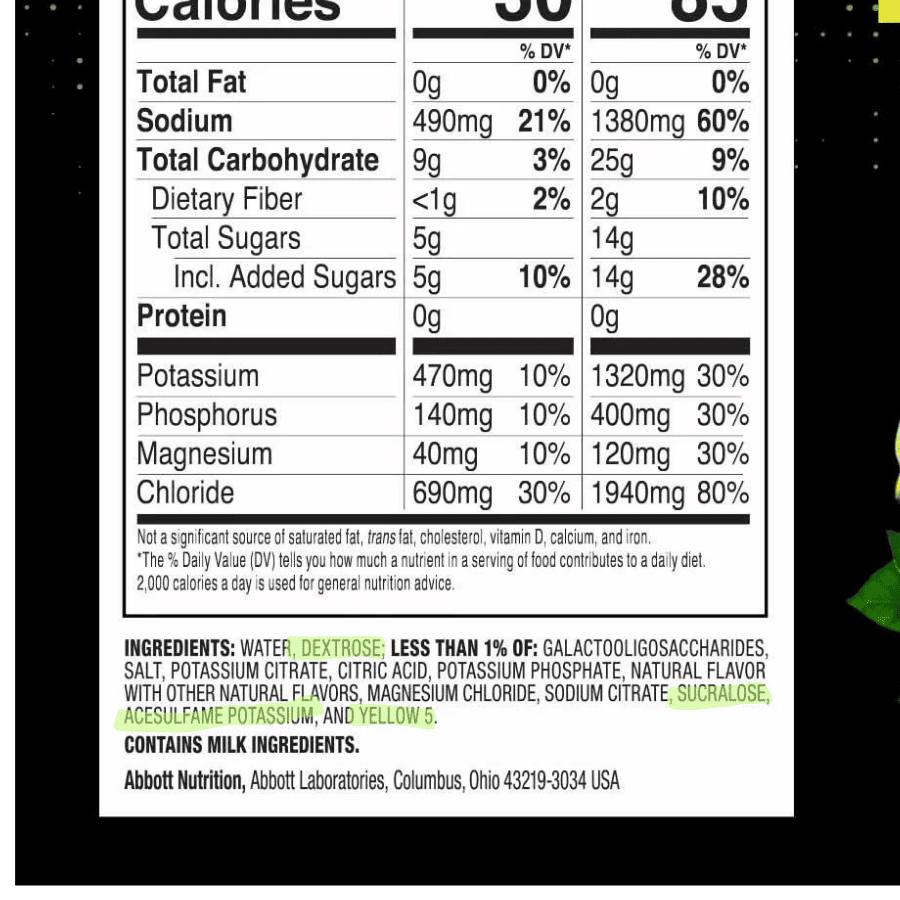
If I had to name a worst kids sports drink, I think I would go with Pedialyte Sport, which is a shame, because some people associate the Pedialyte brand with health.
Propel
Propel is considered an electrolyte-enhanced flavored water. It is dye free and uses natural flavors but is artificially sweetened with sucralose and acesulfame. Their angle at being unique is offering vitamins B3, B5, B6 and antioxidant vitamins C and E.
Prime
Prime starts out good with the second ingredient being coconut water, but if you keep reading the label, you’ll find the same artificial sweeteners (sucralose and acesulfame potassium) that are in Gatorade Zero and Powerade Zero.
The sports drink is 10% coconut water. I will give the brand points for not using artificial dyes. Some of the flavors contain beta carotene for color, which is a much better alternative.
Body Armor
Body Armor is one of the sports drinks that I will buy on occasion. With 25 grams of sugar in a 16 oz. bottle, it’s a treat in my book. It actually only has one less gram of sugar than 16 ounces of Gatorade.
Body Armor contains coconut water and is sweetened with pure cane sugar. The brand uses vegetable juice concentrate for coloring, so it is artificial dye free.
My kids’ favorite Body Armor flavors are the Mamba Forever and Blue Raspberry.
Body Armor Lyte
Body Armor Lyte has similar ingredients to the original Body Armor, but it is sweetened with Erythritol and Stevia Leaf Extract. Just beware that too much erythritol (sugar alcohol) can be hard on little tummies (think gas and bloating). We’ve never had this issue drinking just one.
Favorites for us are the Berry Punch and Blueberry Pomegranate.
Good Sport
Good Sport is a newer sports drink that utilizes deproteinized milk. A 16.9-ounce bottle has 19 grams of sugar. It is sweetened with monk fruit extract and erythritol and contains natural flavors. The brand claims their drink contains 3x more electrolytes and 33% less sugar than similar sports drinks.
Good Sport is not available in most grocery stores, but you can get it at Walmart.com (best price), Amazon and the Good Sport website.
It can be difficult to follow all of the details in paragraph form, so here is a chart comparing some of the main ingredients in kids sports drinks.
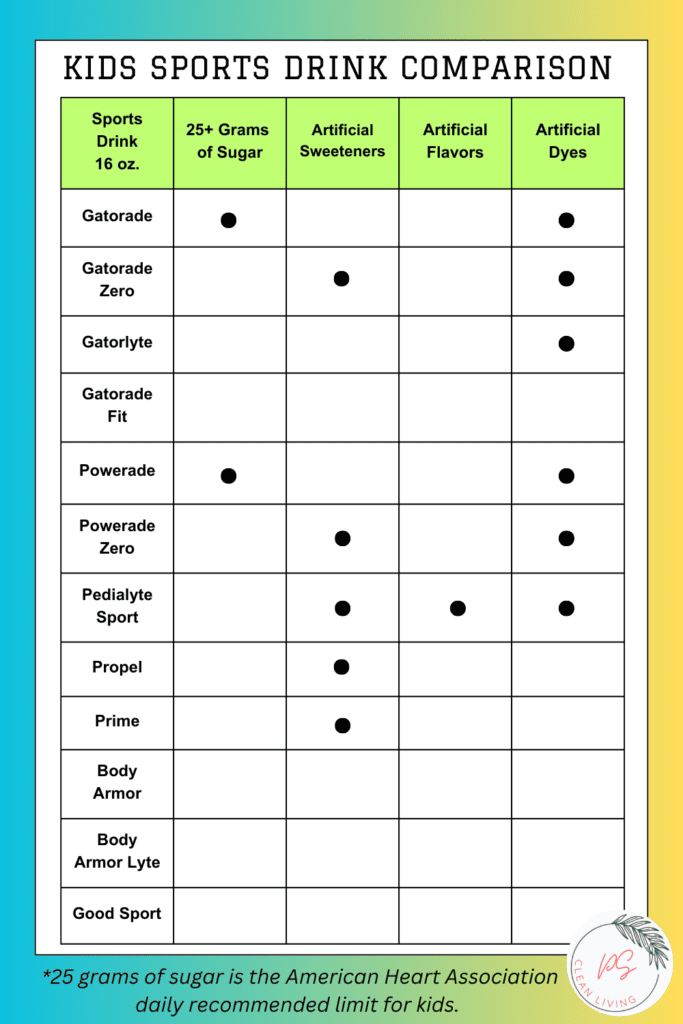
What is the cleanest sports drink for kids?
My top picks for cleanest or healthiest sports drinks for kids are Body Armor, Body Armor Lyte, Gatorade Fit and Good Sport. We have not tried Good Sport just yet, so I can’t speak to taste.
Fair warning, if your kiddo is a die-hard Gatorade fan, these coconut water options will taste a bit different. I’ve heard coconut water described as tasting like dirty dish water LOL!
My best trick is to avoid traditional sports drinks, so they won’t know what they are missing. Ha! This trick will eventually fail, of course. Assuming the cat is out of the bag, hopefully you can find a flavor that your kiddo enjoys.
If not, it can be helpful to simply keep in mind that sports drinks are usually treats rather than nutritional needs (at least in most cases and especially for younger kids).
Also, every sports drink is better when it’s super cold! This is especially true for the ones containing coconut water.
I hope this post helped you find some options for a healthier kids sports drink. If it did, I’d be grateful if you’d share this post with a sports mom (or dad) friend of yours.
